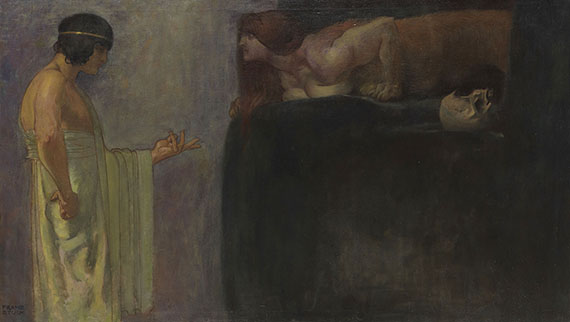Dictionary


Pre-Expressionism
Expressionism as we know it is not imaginable without regarding the reception of a number of its precursors. Mostly the, admittedly cliché-ridden, turn from impressive to expressive art, with which the expressionists tried to break away from the foregone generation of impressionists, was legitimated by referring to some artists from the time around 1900, who laid the foundation for Expressionism, either as individually active artists or as representatives of a movement.
The art of the Norwegian Edvard Munch plays an important role in this context. Not only his anti-naturalist compositions and usage of strong color combinations that were rich in contrast, but also making issues such as psychological tensions and existential fear one of the main subjects of the expressionist generation. A prime example thereof is the painting "The Scream " (1895). Despair emanated by the screaming person seizes the entire composition: The straight lines that lead into the depth and the depressing curves of the sky and the landscape make for the painting's confining atmosphere.
A similar alienation from the world can also be found in the art of James Ensors. This Belgian loner can also be regarded as an important precursor of expressionism. The protagonists in his paintings always wear carnival masks, skeletons as well as grotesque and ghost-like figures, that are combined in eerie compositions with their sense of irony and black humor. His work is socially critical, endued with religious connotations and displays a disillusioned attitude towards the world, an attitude that can be observed with many expressionists. Religious images by Emil Nolde and Alfred Kubin's monstrous vision go back to Ensor's art.
Vincent van Gogh was, without a doubt, another great model for the expressionists, mostly in terms of his sense of line movement, the dissonance, the colors' expressive powers and the composition's psychological force. Also Paul Cézanne's quest for the essential and Paul Gauguin's fascination for exotic, supposedly primitive cultures and his negation of perspective and the emphasized line make for the point of contact for expressionists.
Expressionism as we know it is not imaginable without regarding the reception of a number of its precursors. Mostly the, admittedly cliché-ridden, turn from impressive to expressive art, with which the expressionists tried to break away from the foregone generation of impressionists, was legitimated by referring to some artists from the time around 1900, who laid the foundation for Expressionism, either as individually active artists or as representatives of a movement.
The art of the Norwegian Edvard Munch plays an important role in this context. Not only his anti-naturalist compositions and usage of strong color combinations that were rich in contrast, but also making issues such as psychological tensions and existential fear one of the main subjects of the expressionist generation. A prime example thereof is the painting "The Scream " (1895). Despair emanated by the screaming person seizes the entire composition: The straight lines that lead into the depth and the depressing curves of the sky and the landscape make for the painting's confining atmosphere.
A similar alienation from the world can also be found in the art of James Ensors. This Belgian loner can also be regarded as an important precursor of expressionism. The protagonists in his paintings always wear carnival masks, skeletons as well as grotesque and ghost-like figures, that are combined in eerie compositions with their sense of irony and black humor. His work is socially critical, endued with religious connotations and displays a disillusioned attitude towards the world, an attitude that can be observed with many expressionists. Religious images by Emil Nolde and Alfred Kubin's monstrous vision go back to Ensor's art.
Vincent van Gogh was, without a doubt, another great model for the expressionists, mostly in terms of his sense of line movement, the dissonance, the colors' expressive powers and the composition's psychological force. Also Paul Cézanne's quest for the essential and Paul Gauguin's fascination for exotic, supposedly primitive cultures and his negation of perspective and the emphasized line make for the point of contact for expressionists.
Offers
Headquarters
Joseph-Wild-Str. 18
81829 Munich
Phone: +49 89 55 244-0
Fax: +49 89 55 244-177
info@kettererkunst.de
Louisa von Saucken / Undine Schleifer
Holstenwall 5
20355 Hamburg
Phone: +49 40 37 49 61-0
Fax: +49 40 37 49 61-66
infohamburg@kettererkunst.de
Dr. Simone Wiechers / Nane Schlage
Fasanenstr. 70
10719 Berlin
Phone: +49 30 88 67 53-63
Fax: +49 30 88 67 56-43
infoberlin@kettererkunst.de
Cordula Lichtenberg
Gertrudenstraße 24-28
50667 Cologne
Phone: +49 221 510 908-15
infokoeln@kettererkunst.de
Hessen
Rhineland-Palatinate
Miriam Heß
Phone: +49 62 21 58 80-038
Fax: +49 62 21 58 80-595
infoheidelberg@kettererkunst.de
We will inform you in time.




